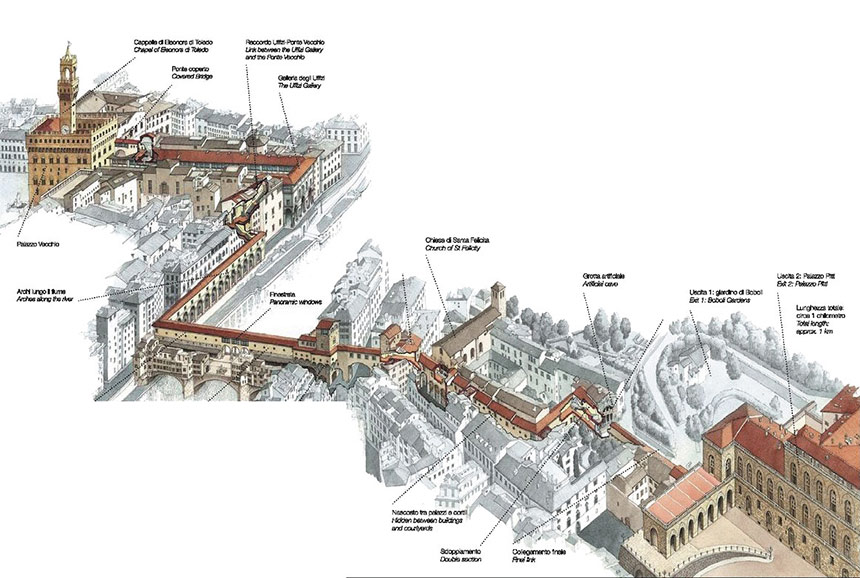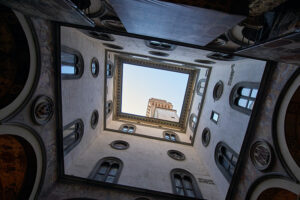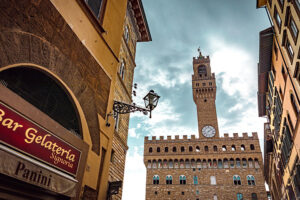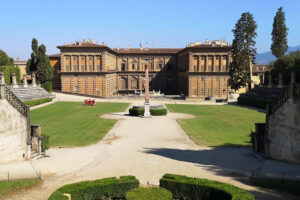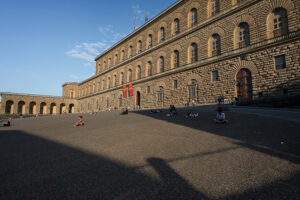The Best Kept Secret in Florence…Tour of Vasari Corridor
Every day is a perfect day to take in a dose of culture and learn something new in Florence. With over 70 museums scattered throughout the city, taking it all in seems like an impossibility. There’s the Accademia, The Palatina Gallery, The National Museum of Bargello…and the list goes on. But what about the hidden gems of Florence that aren’t necessarily the most published or well known? You may think you know how to mark your map, but there’s a must-see place that will take you back to a time when royalty ruled and pedestrian privacy was feasible (if you were the Grand Duke, of course).
Perhaps you’ve done a self-guided tour of the Uffizi Gallery, or even taken the advice of Rick Steves and let the experts lead the way, but did you know there’s a private tour of something so protected, so private, that both a guide and two escorts are required? There is, and it’s called The Vasari Corridor. Attached to the Uffizi Gallery, it’s a hidden wonder that houses some of the most famous self-portrait paintings Florence has to offer. This discreet passageway was commissioned by The Grand Duke Cosimo I de’ Medici in 1564, to be designed by the same architect that brought the Uffizi to life, Giorgio Vasari. At the time, Cosimo desired this one-kilometer walkway from one side of the Arno to the other, not only to be shielded from the general public, but also to showcase his wealth and power to the family of Johanna of Austria, the future wife of his son Francesco.
Intrigued by the history of this tour, I sat down with expert tour guide from Florencetown…Vanessa Garau, she usually guide the group of the “Vasari corridor & Uffizi gallery tour”. Let me tell you something about Vanessa…not only is she an absolute delight to speak with, but she is incredibly knowledgeable for someone of such a young age. She made sure everyone could see and hear her, entertained us with her adorable humor, and provided our group with an excellent overview of a tour that can seem a bit intimidating to a rookie of historical art. She had an honest answer for all our questions and really knew her stuff. Here’s what happened when I put her to the test…
First of all – you’re 23 and you have the knowledge of a historian twice your age. Tell us how you’ve learned so much about The Vasari Corridor and the important works that it houses?
After high school I went on to take a special one-year course, which taught me everything I needed to know about being a tour guide in Florence. In addition, I studied history, art history, and archeology. After completion of the course, I became licensed and was lucky enough to be hired at Florencetown. Being licensed here isn’t just recommended, rather it’s a requirement, as the police are very strict and check the credentials of all the guides. As far as learning about the Vasari corridor, it’s something I really had to work hard at on my own. It’s one of the harder tours to become knowledgeable at, as they don’t allow guides to enter freely and study on their own. It has really been a learn-as-I-go process. Also, as English is my second language and all the tours are given in English, I feel like I’ve had to learn everything twice. It’s definitely a challenging tour to guide!
What’s your favorite piece of art that we can see when we take the tour? Any special reason why?
My favorite piece is not necessarily looked at as the most important or even most well known, but it has great meaning to me, making it stand out amongst the rest. The name of the painting is “Double portrait of Johann Wilhelm von der Pfalz and Anna Maria Luisa de’ Medici” by Jan Frans van Douven. It is placed at the start of the Vasari Corridor, and to me symbolizes the importance of Anna Maria Luisa de’ Medici. After her brother died in 1737, as he never had children, she was the last member of the Medici family to exist. The same year he died, she wrote a family pact (Patto di Famiglia) that said no one could remove any works of art, paintings, sculptures, jewels, etc. from Florence. She wanted to make sure that everything that belonged to the family was left to the city of Florence, which is why we have tours like this and all these precious works are protected by the city. This to me makes her an incredible woman and a large part of why we can still call Florence “the cradle of the Renaissance”.
Wow, that’s amazing. Sounds like keeping her family alive through art was an incredibly important legacy for her to leave behind. With that said, the importance of famiglia in Italy is definitely a reigning ideology. What aspect does the role of family play when it comes to the history of The Vasari Corridor?
Without the entire family of the Medici, this tour could not exist. There is a history here that is told through the artwork, and the entire theme of the tour is based on Cosimo I de’ Medici and the family he created. Even though the idea of family has since changed, it’s still incredibly important to modern-day Italy, and is the basis for a lot of what we see in Florence and all of Italy now.
What sets this tour apart from other tours we can take in the city?
So much! This tour is all about where you are and the experience you have. I suppose it’s not about how important the paintings are, as we can’t really compare the works in the Corridor to what you’ll see in Uffizi Gallery, rather it’s the meaning behind the experience. The idea of being in a secret path, a place that takes you above the city…it’s something you can’t get in a normal museum. When you walk the Corridor, you can almost put yourself back in time and you feel let in on a city secret that most tourists don’t realize exists.
You’re so right…I felt that way when I took this tour! Tell us when the tours run? I heard there’s a morning tour that’s even more exclusive…
The regular tour runs at 3:30pm and lasts about 3 hours. It includes a visit to the Uffizi, where the group gets to skip the line and enter from the offices of the Uffizi – bypassing the other tourists and tour groups. From there, we pass by the highlights of the gallery and enter the Vasari Corridor from the second corridor of the Uffizi. The doors are opened just for us, making the tour completely private to the group. The Corridor is 1km long and exits on the other side of the Arno, right outside the Boboli Gardens and Pitti Palace. In addition to this tour we do a morning tour, which is the one I highly recommend. It’s incredibly special, as it’s the same exclusive experience but with even more VIP treatment. Not only is breakfast included on the terrace of the Uffizi, but the tour leaves at 8am and gets to be among the very first to enter the gallery – making it feel focused and intimate.
Any tourist tips you’d like to give us before taking the tour?
Absolutely! Dress comfortably as there’s a lot of standing and walking. It can get crowded, and since there’s no air conditioning, it usually gets very warm during the busy season. Cameras are not allowed in the Uffizi and Vasari Corridor, but you are allowed to take pictures of the view outside. As the paintings inside the Corridor aren’t protected, I usually encourage taking only small bags with you – they are pretty strict about making sure the art remains untouched so please keep a close eye on your things while enjoying the art! Other than that, my only advice is to come and enjoy this amazing part of our Florentine history. This is an experience you won’t get anywhere else and I can’t wait to share it with you!
Thank you, Vanessa! You truly are an inspiration and an expert at what you do. Makes me want to go home and hit the books!
For more information about booking this tour, please visit: www.florencetown.com

